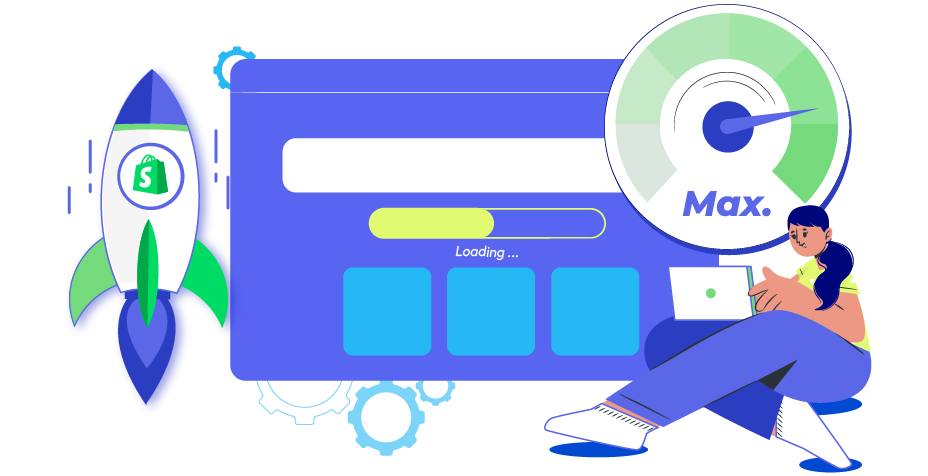The Ultimate Guide for Shopify Speed Optimization
In today’s digital age, speed is pivotal in captivating online customers. Did you know that nearly 40% of visitors abandon a website if it takes more than three seconds to load? When it comes to Shopify stores, optimizing speed is not just an option—it’s a necessity. Research shows that a one-second delay in page response can result in a 7% reduction in conversions.
We’re here to help you unlock the secrets to turbocharging your site. In this guide, discover crucial strategies to rev up your Shopify store’s speed and enhance user experience, ultimately boosting sales and customer satisfaction.
Let’s start right now!
Table of Content
What is Shopify Speed Measurement?

Shopify speed measurement refers to the evaluation of a Shopify store’s loading and performance times. It involves analyzing and quantifying how swiftly the online store’s pages load, its responsiveness, and overall efficiency. This measurement includes assessing various elements such as page loading times, server response times, image and content delivery, and other factors that contribute to the site’s speed. The aim is to identify areas for improvement and enhance the user experience, as faster-loading websites tend to have better user engagement, higher conversion rates, and improved search engine rankings.
How Do I Measure Speed On Shopify Stores?
When it comes to an online store’s success, speed is a crucial factor that can make or break your business. So, how do you measure speed on Shopify stores? There are a few key metrics and tools that provide insights into the performance of your store.
- Page Load Time: This metric indicates how long it takes for your website pages to load completely. Tools such as Google’s PageSpeed Insights, Pingdom, or GTmetrix are fantastic resources that provide insights into your page load times. They deliver a comprehensive analysis, highlighting areas that require improvement.
- Time to First Byte (TTFB): TTFB is the time taken for a user’s browser to receive the first byte of page content from the server. A speedy TTFB is critical as it significantly influences how quickly a page appears to your customers.
- Render-Blocking Resources: These resources hinder the loading of a webpage. Identifying and addressing these can considerably improve load times.
- Total Page Size: The larger the page, the longer it takes to load. Monitoring and optimizing your page size is vital for faster load times.
Google Pagespeed Insights provides a comprehensive analysis of a website’s speed and performance. It measures the loading time and performance of a site for both mobile and desktop devices, offering valuable insights into various metrics, such as First Contentful Paint (FCP) and Largest Contentful Paint (LCP). You can gain actionable recommendations to enhance their site’s speed and optimize user experience, thereby improving search engine rankings and user engagement.

Google Pagespeed Insights Measurements
How do I know if my site is slow?
Recognizing when your Shopify store isn’t performing at its best speed is crucial in the competitive online marketplace. A slow-loading website isn’t just an inconvenience—it’s a roadblock that can deter potential customers and stunt your business growth. How to know if your site is slow is a valid concern. The signs aren’t always as obvious as a turtle racing a rabbit. Understanding these indicators is key to addressing any performance issues your Shopify store might be facing.
- User Experience: Slow sites often lead to high bounce rates. If visitors leave your site quickly or fail to engage with its content, it might indicate slow loading times. Analyze user behavior metrics and feedback to see if visitors are navigating away without exploring your content.
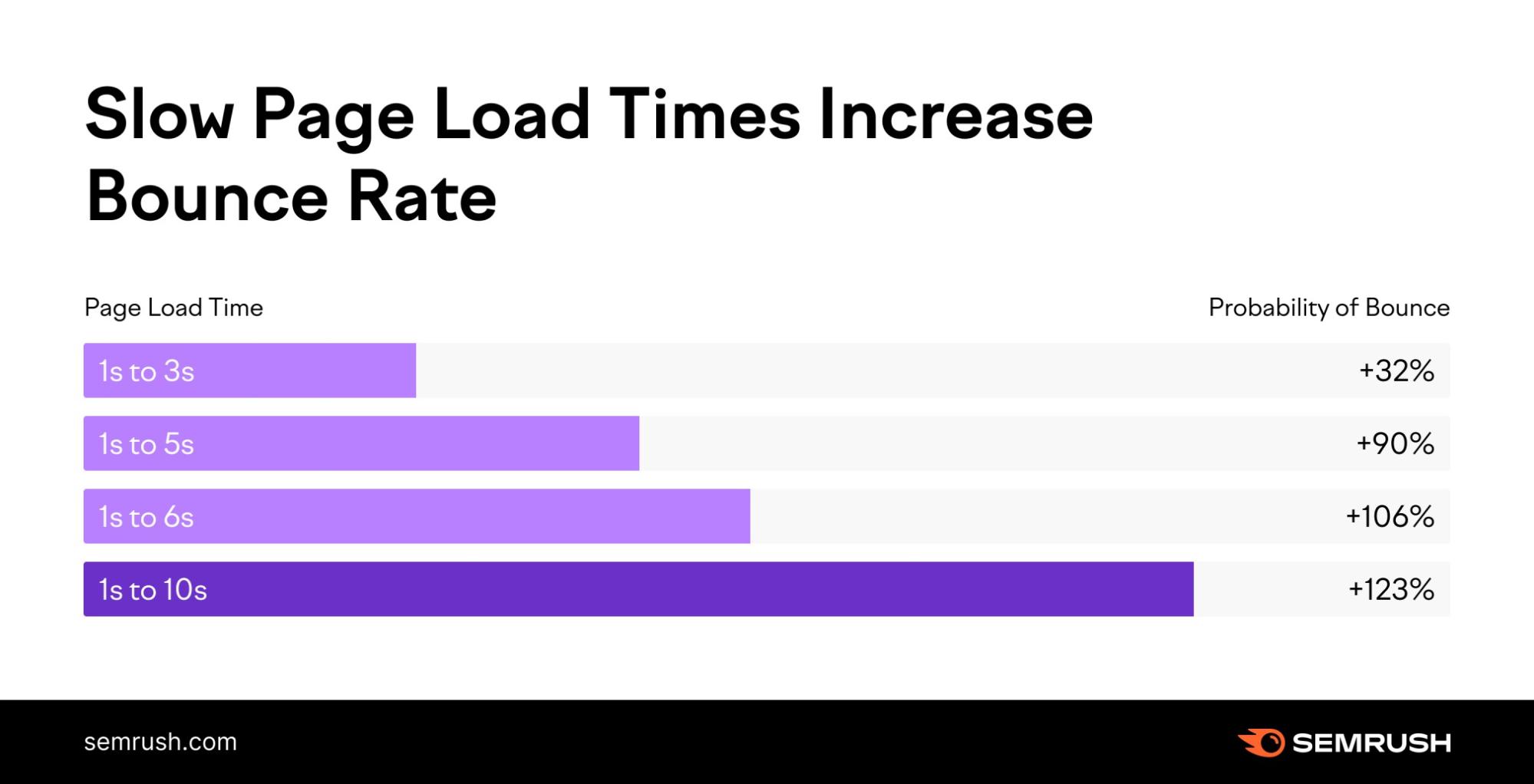
Slow Page Load Times Increase Bounce Rate (Source: SemRush)
- Loading Time: Use tools like Google PageSpeed Insights, Pingdom, GTmetrix, or Shopify’s own tools to measure your site’s loading times. They provide insights into page load times and performance grades. A longer load time than the recommended 3 seconds is generally a sign of a slower site.
- SEO Impact: Site speed is an essential SEO factor. If your site isn’t ranking as well as expected or your SEO performance has suddenly dropped, it might be due to slow site speed.
- Conversion Rates: Slow sites can deter customers from completing purchases or filling out forms. A decrease in conversions or an abandoned shopping cart could be linked to a slow site.
- Mobile Performance: A slow site on mobile devices can lead to a poor user experience. Check mobile performance metrics to ensure your site is equally fast on all devices.
Factors That Affect My Shopify Speed
Several factors can influence the speed and performance of your Shopify store. Addressing these can significantly improve your site’s loading times and overall user experience. Here are some key factors that can affect the speed of your Shopify store:
- Image: Large image files can slow down your site. Optimize images by compressing them without compromising quality. Shopify automatically compresses images, but it’s good practice to use compressed images before uploading.
- App: Excessive or poorly coded apps can slow down your store. Evaluate the necessity of each app and remove those that are unnecessary or causing performance issues.
- Theme: Some themes are more optimized for speed than others. Choose a well-coded, responsive theme that is optimized for performance.
- Code Quality: Poorly written or excessive code in custom themes or modifications can impact loading times. Ensure that your code is clean and efficient.
- Caching: Implement browser caching and utilize Shopify’s built-in CDN (Content Delivery Network) to store static content closer to your users, reducing loading times.
- External Scripts: Minimize the number of external scripts (such as tracking codes, embedded media, etc.) as they can significantly impact load times.
- Server Response Time: Shopify hosts your store, and their servers’ performance can affect your site’s speed. Generally, Shopify has reliable servers, but occasionally, there might be server issues.

- Mobile Optimization: With the increasing number of users accessing websites on mobile devices, ensure that your store is mobile-responsive. This means your store should load quickly and look good on various mobile devices.
- Database: Regularly clean up and optimize your database to improve loading times. Reduce redundant or unnecessary data.
- SSL and Security: Implement SSL (Secure Sockets Layer) to ensure a secure connection. While SSL itself may not directly affect speed, unsecured connections might impact user trust and experience.
Why Should I Optimize My Shopify Site Speed?
The speed of your Shopify store acts as the silent conductor orchestrating the symphony of user experience, search engine rankings, and ultimately, your business success. It’s not just about loading times; it’s about delivering a shopping experience that captivates, engages, and converts. Let’s delve deeper into the significance of site speed and how it weaves into the fabric of your online business.
Enhanced User Experience: The Path to Customer Delight
Speed is the linchpin of an exceptional shopping experience. Imagine strolling into a store where everything is precisely where it should be – that’s what a fast website feels like. Quick-loading pages invite users to explore without the frustration of waiting. It’s about making their journey smooth, enjoyable, and worthwhile, which ultimately fosters brand loyalty and repeat visits.
Improved SEO Performance: Catching Google’s Attention
Search engines love speed as much as users do. A zippy site not only keeps users engaged but also wins favor with search algorithms, potentially catapulting your store higher in search engine result pages. It’s your ticket to increased visibility and organic traffic.
Higher Conversion Rates: The Need for Swiftness
The seconds it takes for your page to load can make a monumental difference. Faster sites lead to higher conversion rates – visitors linger longer, add items to carts, and complete purchases. It’s a direct correlation between speed and revenue.
Reduced Bounce Rates: Keeping Visitors Engaged
Slow-loading sites are the virtual turn-offs. By optimizing speed, you decrease bounce rates. Visitors stay, explore, and engage, leading to a higher chance of conversions.
Mobile Responsiveness: The Mobile Momentum
Mobile devices are the gateway to online shopping for many. Ensuring your site is not just fast but mobile-responsive is essential. Users want a seamless shopping experience, no matter the device they’re on.
Competitive Advantage: Speed as Your Unique Selling Point
In the competitive world of e-commerce, a faster site can be a game-changer. It speaks volumes about your brand – professional, reliable, and forward-thinking.
Cost-Efficiency: Saving While Speeding
Apart from user benefits, an optimized site can save you money. Reduced server demands mean cost savings in the long run. Speed becomes an ally to both your users and your budget.
Shopify Speed & Performance Optimization Services
We'll help you achieve lightning-fast page load times, reduce bounce rates, and improve the overall user experience for your customers.
Learn moreShopify Speed Optimization Best Practices
1. Image Optimization

Optimizing images is a crucial step in improving page speed for your Shopify store. Here’s a comprehensive guide on how to optimize images effectively:
- Image Compression
- Choose the Right File Format: Select the appropriate file format. Use JPEG for photographs and PNG for images with transparency or sharp details.
- Resize Images: Ensure your images are appropriately sized. Use the correct dimensions required by your Shopify theme.
- Compression Tools: Utilize image compression tools like TinyPNG, ImageOptim, or Squoosh to reduce file size without compromising quality.
- Shopify Image Optimization: Upload images directly to Shopify, which automatically compresses images without losing quality.
- Lazy Loading Apps: Consider using Shopify apps that enable lazy loading. This feature defers the loading of images until they’re about to come into view, reducing the initial page load time.
- Image SEO and Naming
- Optimize File Names: Use descriptive, SEO-friendly file names. For instance, “red-dress.jpg” is better than a generic “IMG001.jpg”.
- Alt Text: Provide descriptive alt text for images. Alt text not only helps with SEO but also ensures accessibility for visually impaired users.
- Content Delivery Networks (CDNs): Leverage Shopify’s built-in CDN. It stores images closer to the user, reducing the time it takes to fetch images.
- Consider WebP Format: For modern browsers, consider using the WebP format for its better compression and quality, as it can improve load times.
2. Theme Selection
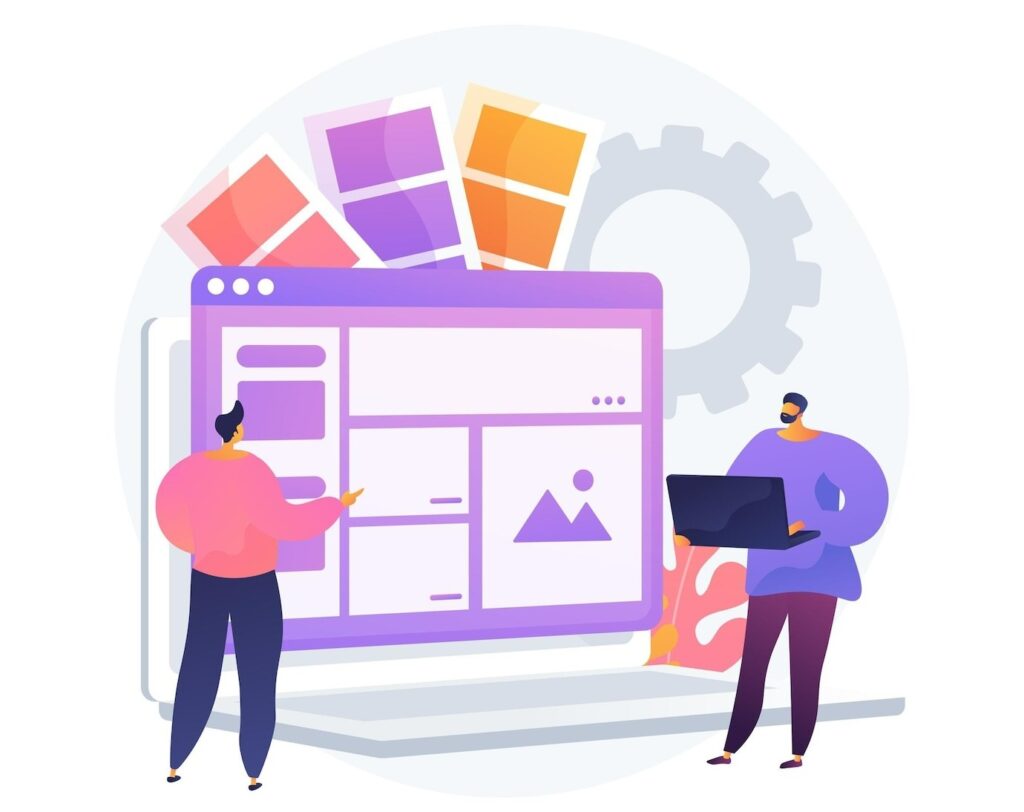
When it comes to your Shopify store, the theme you choose sets the stage for your online presence and significantly impacts your site’s speed and performance. An optimized theme is the key to a faster, more responsive online store. Here we introduce you a guide on how to choose a theme and optimize it for better performance:
- Selecting Themes: Choosing a theme isn’t just about looks; it’s about functionality. Opt for themes that are lightweight and designed for speed. Look for themes developed by reputable designers or those recommended by Shopify.
- Theme Reviews and Ratings: Consider themes with positive reviews and high ratings. These themes are more likely to be optimized for speed and better performance.
- Built-in Performance Features: A theme with built-in speed optimization features, such as lazy loading for images and efficient CSS and JavaScript handling, can significantly impact your store’s speed. Test themes using tools like Google PageSpeed Insights to understand how they affect load times.
- Avoid Unnecessary Custom Code: Customizations are great for branding, but excessive custom code can slow down your site. Stick to essential modifications and avoid unnecessary code that could impact your store’s speed.
- Stay Updated: Themes that receive regular updates often come with performance improvements, bug fixes, and better speed enhancements. Ensure your chosen theme is actively maintained by its developers.
- App Compatibility: Ensure the theme is compatible with essential Shopify apps. Incompatibility can cause conflicts that affect your store’s speed and functionality.
- Clean and Simple: Opt for a theme with a clean and straightforward design. Overly complex designs or heavy graphical elements can increase load times.
After choosing a theme, regularly monitor your site’s performance. Tools like Google PageSpeed Insights can identify any issues affecting speed and help you address them promptly.
3. App Usage
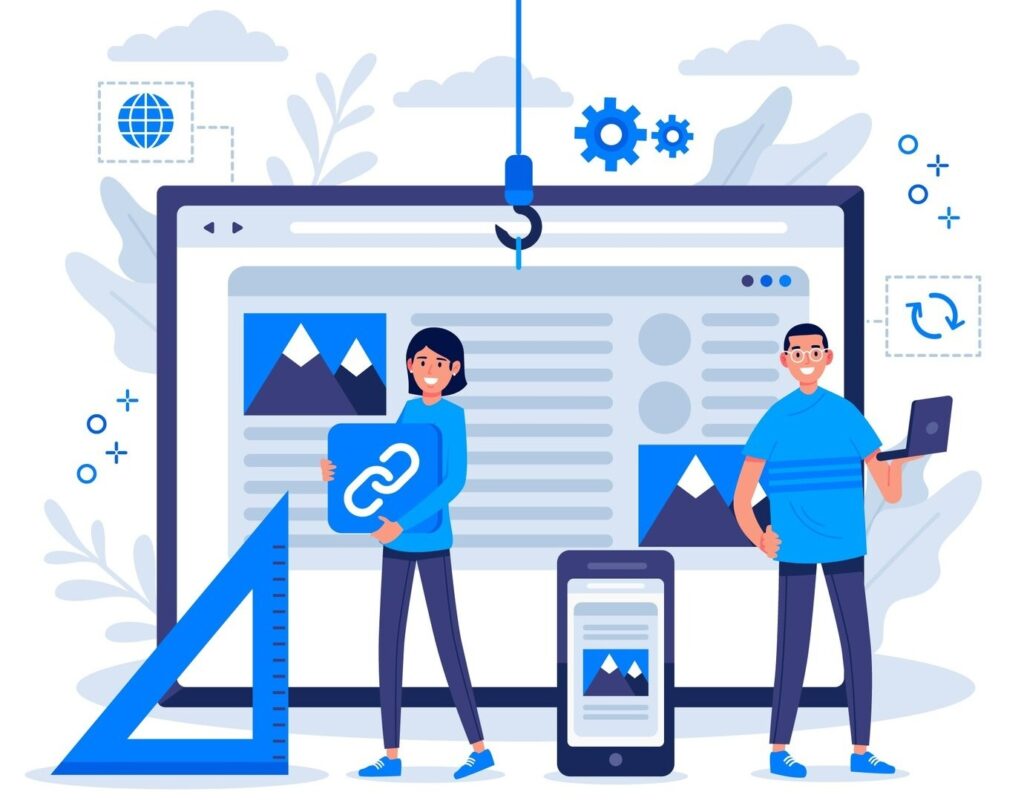
Apps are powerful tools to enhance your Shopify store’s functionality, but an excessive or poorly optimized app ecosystem can slow down your site. Optimizing app usage is crucial for maintaining a speedy and efficient online store. Let’s explore effective strategies to optimize app usage and improve page speed.
Audit and Assess Your Apps
- Evaluate App Necessity: Regularly review installed apps. Determine if each app is essential for your store’s functionality or if it duplicates features already provided by other apps.
- Performance Impact: Assess the impact of each app on your site’s speed. Identify and remove apps that significantly slow down your store without adding substantial value.
Opt for Well-Optimized Apps
- Choose Performance-Optimized Apps: Prioritize apps known for their efficiency and speed optimization. Look for apps developed by reputable providers with a track record for performance.
- Integrated Functionalities: Consider utilizing Shopify’s built-in functionalities where possible to minimize the need for additional apps, reducing the load on your site.
Utilize Necessary Features
- Selective Activation: Activate only the necessary features within an app. Deactivate any features or functionalities that are surplus to your store’s requirements.
- Efficient Code Implementation: Ensure the app’s integration is coded efficiently and doesn’t add unnecessary script or code that could slow down your site.
App Updates and Compatibility
- Regular Updates: Keep your apps updated. Developers often release updates to fix bugs, enhance performance, and ensure compatibility with the latest Shopify versions.
- Check for Compatibility: Ensure your apps are compatible with your theme and other installed apps. Compatibility issues can lead to conflicts and slower load times.
4. Code Quality

Efficient and clean code is the backbone of a fast-performing Shopify store. Ensuring optimal code quality is pivotal in enhancing your site’s speed and performance. These following steps will help you to optimize page speed by focusing on code quality.
Efficient Coding Practices
- Clean and Lean Code: Write clean, concise code that adheres to best practices. Remove unnecessary code and comments. A leaner codebase results in faster loading times.
- Minimize HTTP Requests: Reduce the number of HTTP requests your site makes by combining and minifying CSS and JavaScript files.
Proper Theme Customization
- Theme Modifications: Limit theme customizations to the essentials. Excessive custom code can impact loading times. Ensure customizations are efficient and well-documented.
- Use Child Themes: When making theme modifications, use child themes to avoid altering the core theme files. This makes it easier to update the main theme without losing your customizations.
Image Optimization in Code
- Responsive Images: Code your site to serve responsive images based on the user’s device, ensuring that the right image size is delivered for each screen size.
- Lazy Loading: Implement lazy loading for images in your code, so they load as users scroll down the page, reducing initial load times.
Server-Side Optimization
- Database Queries: Optimize database queries in your code to reduce server load and speed up data retrieval. Use indexes and caching where applicable.
- Content Compression: Enable server-level content compression to deliver smaller page sizes to users, reducing load times.
Performance Testing and Monitoring
- Regular Testing: Use performance testing tools like Google PageSpeed Insights and GTmetrix to assess your site’s speed. Address any code-related issues identified by these tools.
- Code Profiling: Use code profiling tools to identify bottlenecks and performance issues within your code. Tools like New Relic or Xdebug can help.
Code Quality Tools
- Code Linters: Use code linting tools such as ESLint (for JavaScript) and RuboCop (for Ruby) to enforce coding standards and identify potential issues.
- Code Reviews: Conduct regular code reviews to ensure that code quality and performance optimization are consistent throughout your development process.
5. Caching and CDN

Caching and Content Delivery Networks (CDNs) are powerful tools that significantly boost a website’s speed by storing and delivering content more efficiently. Here is how leveraging caching and CDN can optimize the page speed of your Shopify store.
- Browser Caching: Implement browser caching to store website data on the visitor’s device. This reduces the need to re-download assets on subsequent visits, speeding up load times.
- Caching Apps: Utilize caching apps available on Shopify’s app store to manage and control the caching settings on your store.
- Content Delivery Network (CDN): Shopify includes a built-in CDN that distributes content across multiple servers globally. Leverage this feature to reduce latency and serve content faster to users worldwide.
- Set Cache-Control Headers: Configure cache-control headers to specify how long files should be cached. This can be managed through the settings in your server or through Shopify’s backend.
- Selective Caching: Identify parts of your site that can be cached without affecting the user experience. Cache static content while allowing dynamic content, like shopping cart details, to remain uncached.
- Third-Party Caching Services: Consider integrating third-party caching services such as Varnish or Cloudflare, which provide advanced caching functionalities and can work in tandem with Shopify’s built-in features.
- Cache Eviction: Implement a strategy for cache eviction to ensure that outdated content is removed from the cache to maintain the freshness of your site.
- Cache Refresh: Plan for cache refresh at regular intervals or when content is updated to keep the cache up-to-date without stale information.
6. Optimizing External Scripts
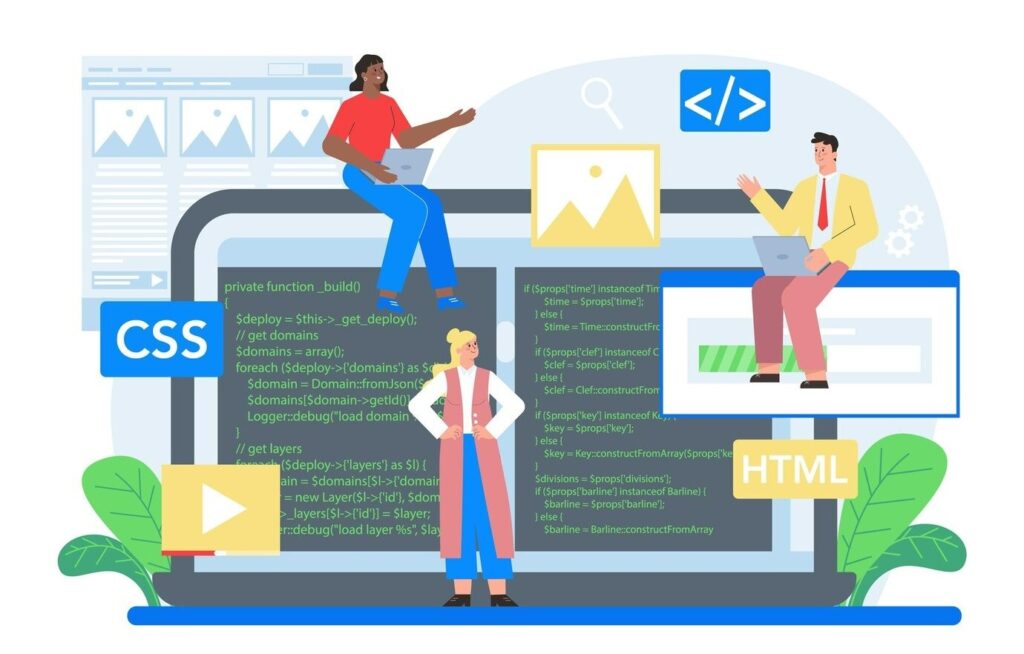
External scripts, including those for tracking, analytics, and third-party services, can impact your Shopify store’s loading speed. Optimizing these scripts is crucial for ensuring a faster, more responsive website. The strategies to optimize external scripts and improve your site’s page speed are:
- Asynchronous Loading: Load non-essential scripts asynchronously to prevent them from blocking the rendering of critical page content. This allows your main content to load first, improving perceived speed.
- Deferred Loading: Defer the loading of non-essential scripts until after the main content has loaded. This technique ensures a smoother initial page load experience for users.
- Minimize and Prioritize Scripts: Minimize the number of external scripts used on your site. Consider only essential services to limit the impact on load times. Prioritize the loading of critical scripts necessary for the initial display of your site, such as stylesheets and key JavaScript elements.
- Optimization Tools: Use optimization tools or services provided by third-party script vendors to reduce file sizes or enhance their loading efficiency.
- Script Management and Removal: Periodically audit your external scripts to identify redundant or unnecessary ones. Remove or replace scripts that don’t significantly contribute to your site’s functionality or user experience. Remove unused or outdated scripts to declutter your site and enhance loading speed.
7. Mobile Optimization

Mobile devices are a significant gateway to online shopping. Optimizing scripts specifically for mobile can significantly enhance the performance and user experience of your Shopify store. Here are helpful tips to optimize scripts for mobile platforms and improve page speed.
- Mobile-Targeted CDN: Use a Content Delivery Network (CDN) specifically optimized for mobile platforms. CDN delivery of scripts ensures faster loading times by serving content from servers closer to mobile users.
- Mobile-Only Essential Scripts: Minimize the number of scripts loaded on mobile platforms. Prioritize loading only essential scripts necessary for core functionalities on mobile devices.
- Mobile-First Strategy: Develop scripts with a mobile-first approach. Focus on creating scripts optimized for mobile platforms and then scale up for larger devices if needed.
- Mobile-Specific Testing: Conduct performance testing using mobile-specific testing tools. Evaluate your site’s speed on mobile platforms to identify and address mobile-specific speed issues.
8. Database Optimization

Database optimization is a crucial yet often overlooked aspect of improving page speed in a Shopify store. Efficient database management can significantly impact loading times and overall site performance.
Regular Database Cleanup
- Data Review and Cleanup: Periodically review and clean up your database. Remove redundant, outdated, or unnecessary data to streamline operations.
- Unused Data Removal: Delete old or unused entries such as outdated product listings, customer information, or redundant records to declutter the database.
Index Optimization
- Database Indexing: Use indexing to optimize database queries. Index frequently queried fields to speed up data retrieval.
- Regular Index Maintenance: Regularly review and optimize the indexing strategy to ensure it aligns with the evolving data patterns and usage.
Query Optimization
- Optimize Database Queries: Analyze and optimize the efficiency of your database queries. Use efficient query writing techniques to retrieve data faster.
- Reducing Complex Queries: Minimize complex or resource-intensive queries that can slow down the database.
Database Caching
- Caching Strategy: Implement database caching to store frequently accessed data in memory. This reduces the need to retrieve data from the disk, enhancing speed.
- Memory Optimization: Allocate sufficient memory for caching to effectively store frequently accessed data for faster retrieval.
Use Efficient Database Managers
- Shopify Database Manager Tools: Utilize efficient database manager tools available in the Shopify ecosystem. Tools like Oracle or Excelify can aid in optimizing and managing database operations.
Regular Backup and Maintenance
- Scheduled Backups: Perform regular backups of your database. Regular maintenance ensures data integrity while minimizing the risk of database issues affecting performance.
Data Compression and Archiving
- Data Compression: Compress large or less frequently accessed data to reduce storage requirements and optimize data retrieval times.
- Archive Historical Data: Store historical data in separate archives to keep the live database lean and responsive.
How to maintain a speedy Shopify store?
Achieving and sustaining a speedy online store involves more than just a one-time fix. It’s an ongoing commitment to continuous improvement and maintenance. To maintain a high-performing Shopify store, you should consider the following strategies and practices.
- Regular Performance Monitoring: The journey to a fast Shopify store begins with consistent performance monitoring. Use tools like Google PageSpeed Insights, GTmetrix, and Shopify’s built-in analytics to regularly evaluate your site’s speed. Keep a close eye on load times, page sizes, and other key metrics.
- Optimize Images and Visual Content Continuously: Images play a pivotal role in your store’s appeal, but they can also weigh down its speed. Continuously optimize images by using compression tools, ensuring appropriate sizes, and leveraging Shopify’s built-in image optimization features.

- Streamline App Usage for Efficiency: Apps can add functionality but can also slow down your store. Regularly audit your apps and eliminate unnecessary ones. Stick to well-optimized apps and leverage built-in Shopify functionalities to reduce the reliance on additional apps.
- Continual Testing and Improvement: Constantly test, assess, and fine-tune your store. Conduct A/B tests, monitor server response times, and keep refining your strategies based on performance metrics. The quest for improvement never stops.
How Much Does It Cost To Speed Up My Shopify Store?
DIY Optimization
- Free or Low-Cost Methods: Using built-in Shopify features for image optimization or CDN utilization. Performing simple theme adjustments, code clean-ups, and app management on your own, which might not require direct expenses but your time and expertise.
- Paid Apps or Tools: Some apps available on the Shopify app store might offer features for optimizing images, managing caching, or improving site speed. Costs can range from a few dollars to monthly subscription fees.
Professional Services
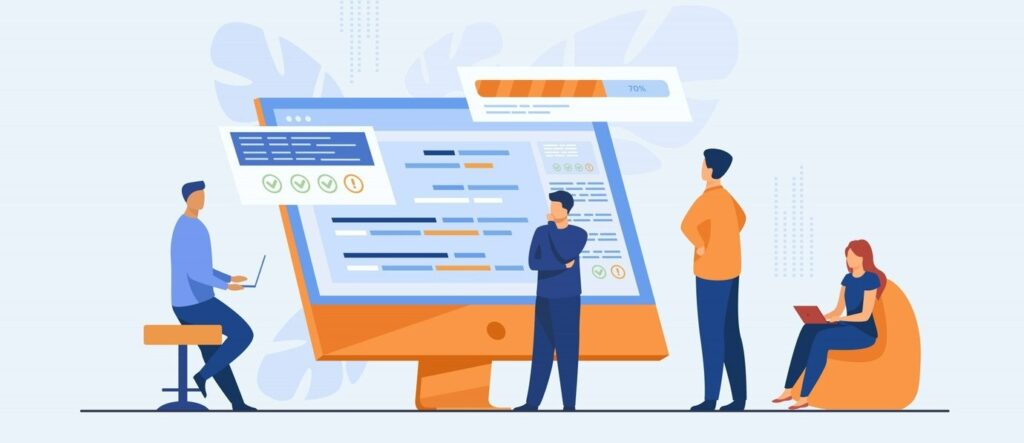
- Expert Consultation: Hiring a developer or agency to perform a thorough audit and optimization of your store. This can range from a few hundred to several thousand dollars, depending on the scope of work.
- Ongoing Maintenance: Engaging in a long-term contract or periodic services for continual maintenance and optimization. Costs here can also vary significantly, usually starting at a few hundred dollars and increasing based on the services provided.
- Theme or App Development: Custom development or modification of themes, apps, or scripts can have separate costs based on the extent of the work and the expertise of the developers.
The costs for professional services are highly variable and are influenced by factors such as the size of the store, the complexity of optimizations required, the experience of the service provider, and the ongoing support or maintenance needed. It’s advisable to get quotes and discuss specific needs with service providers to determine the most suitable solution based on your budget and requirements.
Speed Up and Maintain Your Shopify Store Speed With Mageplaza’s Solutions

At Mageplaza, we stand as your dedicated and experienced eCommerce solution advisor. With over a decade in the industry, our mission is to bring forth tailored digital solutions that drive success for businesses seeking transformation in the digital realm. With a wealth of experience and a commitment to transparency, loyalty, and dedication, we aim to be a reliable partner for your digital commerce journey.
- Extensive Knowledge & Experience: With nearly a decade of experience in eCommerce, Mageplaza has collaborated with hundreds of thousands of online shops across various eCommerce platforms like Magento/Adobe Commerce and Shopify. Offering 120+ ready-made digital solutions and numerous tailored options, we provide a wealth of expertise to cater to diverse business needs.
- Loyalty & Dedication: We are your loyal and devoted partner in the eCommerce space. With a sincere approach, we leverage almost a decade of experience and wisdom in eCommerce to guide hundreds of thousands of customers towards success.
- Transparency: We believe in complete transparency in our dealings. Unlike agencies that limit customer participation in discussions and project management, Mageplaza offers maximum space for customers to engage, understand, critique, monitor progress, and approve work. No secrets or hidden information – just open communication.
- Your Business Is Ours: When you work with Mageplaza, we treat your business as our own. We listen, understand, and take care of your eCommerce website as if it were our own project. Your pain is our pain, and your ambitions are our ambitions.

At Mageplaza, our expert services are designed to address these issues and deliver substantial improvements in your site’s speed. Here’s a snapshot of what we offer:
- Comprehensive Speed Analysis: A detailed assessment to identify areas for improvement, including page load times, server responses, and overall website performance.
- Google PSI Audit: Measuring performance against Google’s standards to offer optimization recommendations for both desktop and mobile devices.
- Shopify App and Plugin Analysis: Ensuring that installed apps and plugins do not negatively impact your site’s speed; removing unnecessary ones.
- Image and Web Font Optimization: Reducing file sizes, optimizing images, and enhancing web fonts to boost load times.
- Server and Hosting Optimization: Enhancing speed and performance by configuring settings, upgrading resources, and implementing load balancing solutions.
- Browser Caching and Code Optimization: Reducing page load times and server responses by optimizing code and caching content.
- CDN Implementation and File Request Reduction: Improving load times and reducing server responses by implementing CDN and streamlining file requests.
- Lazy Loading and Mobile Optimization: Enhancing load times by loading content as users scroll, and optimizing design and content for mobile devices.

Mageplaza’s Shopify Speed Optimization services are not just about increasing speed; they’re about transforming your online store’s performance. With our tailored strategies, we aim to provide a seamless, lightning-fast shopping experience for your customers. Fast-track your success with Mageplaza’s optimization services!
Final Thoughts
In the dynamic e-commerce landscape, the speed of a Shopify store plays a pivotal role in attracting customers and boosting sales. Understanding the key metrics and indicators of a slow-performing store is crucial for business success. Addressing various factors influencing speed and employing best practices, such as those provided by Mageplaza, can significantly transform a store’s performance.
Maintaining speed is an ongoing commitment, and investing in optimization not only ensures a seamless user experience but also contributes to higher SEO rankings, increased conversion rates, and a competitive edge in the market. Fast-tracking success involves a continuous pursuit of speed optimization, making Mageplaza’s expertise and dedicated services an invaluable asset for businesses seeking to enhance their Shopify stores.
& Maintenance Services
Make sure your store is not only in good shape but also thriving with a professional team yet at an affordable price.
Get StartedNew Posts

November 2024

Top 10 Shopify ERP Solutions to Improve Operation Efficiency

Set Up Subscriptions On Shopify In 3 Minutes
People also searched for
- 2.3.x, 2.4.x
Stay in the know
Get special offers on the latest news from Mageplaza.
Earn $10 in reward now!





